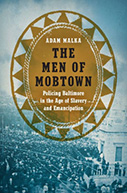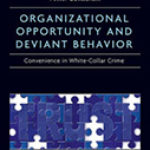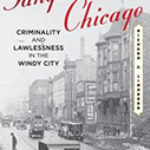The Men of Mobtown: Policing Baltimore in the Age of Slavery and Emancipation

Author: Adam Malka
Publisher: Chapel Hill, NC: University of North Carolina Press, 2018. 352p.
Reviewer: Joshua Clark Davis | July 2019
The last decade has witnessed an outpouring of historical works on policing and prisons in the United States. Historians such as Heather Thompson, Elizabeth Kai Hinton, Dan Berger, Max Felker-Kantor and more have probed the origins and nature of mass incarceration as it has developed since the 1960s. Working in the wake of legal scholar Michelle Alexander, other historians including Khalil Muhammad, Sarah Haley, and Talitha LeFlouria have sought to document how prisons and police constituted a central component of what we might call the “old Jim Crow,” that is the system of legal segregation and white supremacy that flourished in the United States, especially in the American South, from the late nineteenth century to the 1960s.
The Men of Mobtown, by contrast, is one of the very few works to examine policing in the era of slavery and Reconstruction. It is an ambitious work at that, trenchantly argued and impressively researched. Malka’s choice of Baltimore is a wise one. One of America’s three largest cities for the first half of the nineteenth century, Baltimore did not entirely belong to either the North or South. It was one of America’s major hubs for industrial wage labor and a one of the leading ports of entry for European immigrants, but it was also a city that enslaved blacks through most of Civil War, even as it was compelled by U.S. troops to ally with the Union. At the same time, no city was home to more free African Americans than Baltimore. Black and white, free and enslaved, industrial but still intimately tied to the agricultural South, Baltimore in the middle of the nineteenth century offers a revealing window into the glaring contradictions of the economic and racial order in antebellum America.
Baltimore was known as Mobtown for a reason. Over the course of the nineteenth century, wild crowds of violent white men wreaked havoc on the city in a series of riots, including the anti-federal bank riots of 1835 and the 1861 riots in which Confederate sympathizers attacked Union troops passing through the city. But aside from these well-known instances of mob violence, smaller bands of white vigilantes frequently took it upon themselves to police their city and to detain and periodically assault individuals they believed to have committed crimes, working in concert with night watches and other guards and turning suspects over to city authorities. As Malka explains, white male vigilantes functioned as an important antecedent to modern police. And even for some years after the establishment of Baltimore’s police force, vigilantes served a reduced but not inconsequential supporting role in policing in Baltimore.
Vigilantism took on a particular anti-immigrant bent in the 1850s as the xenophobic American Party—better remembered as the Know Nothings–gained control of the city hall in 1855. Two years later, Baltimore established its first municipal police force, one of the first dozen in the country, with many of the inaugural generation of officers coming from the ranks of the Know Nothings. White mobs also imposed their own sense of racial order on workplaces throughout the city, attacking free Blacks and immigrants to force them out of competitive lines of manual labor and craft work, often while police officers looked on without intervening.
Indeed, the line between public and private policing was almost non-existent prior to the 1850s. While white men were expected to detain and arrest any individuals they witnessed breaking the law, enslaved Blacks of course were never permitted to physically restrain whites, but neither were so-called free Blacks. While they did escape the oppressive burden of forced labor, free African Americans had little to no standing in Baltimore’s legal system, either as witnesses or as victims.
One of the ironies of liberal reform that created Baltimore’s police force was that this new system protected enslaved people. After all, one of the express goals of establishing a police force was to protect property, and enslaved Blacks were regarded as property. When enslaved people ran afoul of the law—by physically challenging whites or by escaping slavery—arrest and punishment was not the responsibility of Baltimore’s police force and penitentiary, but the duty of the slaveholder. But in their limited interactions with the slaveholding system, Baltimore city courts were particularly cruel in at least once regard: judges frequently sentenced free Blacks convicted of crimes as minor as theft by ordering them to be sold into slavery.
Malka’s most significant—and perhaps most dismaying—intervention is to explain how the liberal goal of abolition itself helped to criminalize African Americans. With the Thirteenth Amendment’s exemption for forced labor for those convicted of crimes, white liberal advocates of Reconstruction, not slaveholders, planted the seeds of a massive wave of arrests and incarceration that beset African Americans in Reconstruction.
The white liberals who constructed the Reconstruction-era criminal justice system in Baltimore did not want slavery by another name. They did want African Americans to be free—but only certain African Americans. These liberals wished freedom for Blacks who could restrain and overcome what they believed to be their natural inclination to indolence, disorder, and criminality. To maintain their freedom, Black men were expected not only to obey laws but also to remain self-sufficient and economically support their household and dependents. Not surprisingly, the passage and intensified enforcement of vagrancy statutes in Reconstruction was one of the most common charges brought against Black men. In short, most white liberals in the Reconstruction era viewed Blacks’ claim to freedom not as a Constitutional right, but as a privilege that was conditional on good behavior.
In multiple instances Malka’s story of Reconstruction-era Baltimore reminds ones of problems of contemporary law enforcement in America. To name just one example, in 1867 a group of officers was called to a Black household to settle a domestic dispute between Jordan and Eliza Murray. As the police attempted to arrest the couple, neighbors interceded and begged the men to stop. One officer, Gottlieb Frey, pulled his gun, and as witnesses pleaded with him to put it down, shot and killed Eliza. Within days, a prosecutor issued a warrant for Frey’s arrest, and a judge ordered him jailed, but ultimately a grand jury refused to indict Frey. In reading such a story, one cannot help but think of Freddie Gray, who died in the custody of the Baltimore Police Department in 2015, or the countless unarmed Black individuals who have been fatally shot by police who only very occasionally are convicted or even indicted of any crimes.
Explosive increases in the rates of arrest and incarceration for Black Baltimoreans during Reconstruction is another of Malka’s more disturbing revelations. Blacks’ proportion of city jail inmates for a wide range of charges increased dramatically from 1861-1870. Most dramatic was vagrancy, for which Blacks increased from just over 1 percent of all arrests in 1861 to 26 percent in 1870. Similar increases were seen in that same period in Blacks’ proportion of property crime arrests, which rose from 27 to 54 percent, and “personal crimes,” for which Blacks’ proportion of all arrests skyrocketed from 8 to 34 percent. All the while, African American’s share of Baltimore’s total population remained roughly the same, rising only slightly from 17 to 19 percent of the city’s total population from 1861 to 1870 (p. 231, 236). Perhaps most revealing was how much more likely Blacks were to serve prison time after abolition than before. In 1863, African American males made up just 23 percent of Baltimore’s penitentiary population. But by 1871, Black men comprised a whopping 61 percent of all inmates at the Baltimore penitentiary, over 3 times the proportion they made up of the general population.
Black freedom was a threat to many whites, both during and after the era of slavery. With abolition, the nature of white policing of Blacks may have changed as the police became more formalized, as the rates of arrest and incarceration of Blacks increased rapidly, and as authorities relied less on white vigilantes to enforce order. But the rationale of regulating, restraining, and in some cases revoking Black freedom did not change. Most supporters of Reconstruction, Malka shows, believed that Blacks still had to earn their freedom through obedience to the law, and if they somehow went astray it was entirely acceptable to then imprison them and, in many cases, attempt to reform them with forced labor.
The Men of Mobtown is a remarkable book. With a critical eye to the systematic white supremacy that undergirded policing during and after slavery, Malka convincingly shows that white liberal supporters of police reform, abolition, and Reconstruction could not help but imbue their version of criminal justice reform with their assumptions of Blacks’ susceptibility to criminality. Malka’s major achievement is to force readers to consider how today’s racial disparities in policing and incarceration are rooted not only in the last fifty years, or in Jim Crow, but in liberal attempts at Reconstruction and the abolition of slavery.
Works like Malka’s are all the more needed as police forces across the country—including Baltimore’s—struggle with growing demands to discontinue racially unequal policing practices and in some cases to carry out reforms laid out in binding consent decrees with the U.S. Department of Justice. By investigating the surprising outcomes of the abolition of slavery in Baltimore, a city that was not quite entirely Northern or Southern, Malka exposes a most discomforting truth about American criminal justice. For that, scholars of police and prisons—or really anyone who hopes for a racially equitable criminal justice system in the United States—have reason to be thankful.
Joshua Clark Davis, Assistant Professor of History, University of Baltimore


